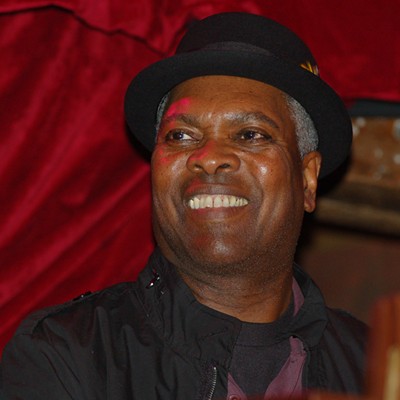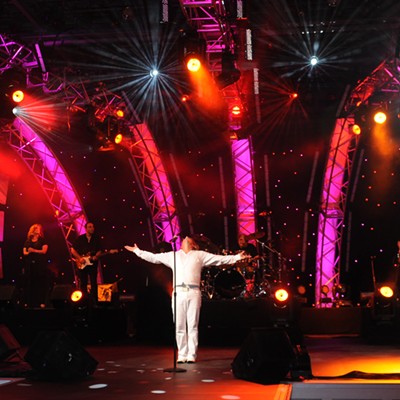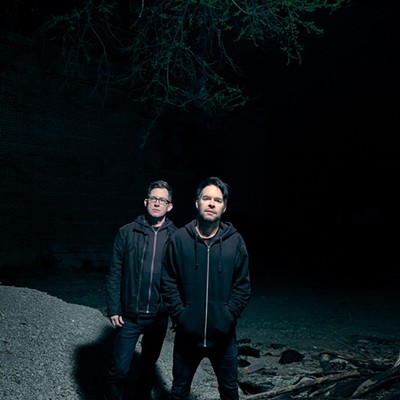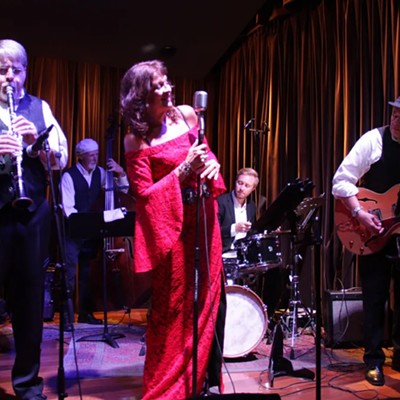"I was really kind of drunk," Dissard says now. "I remember it was outdoors at Congress, but I can't remember much else about it."
She says she had no idea at the time that the performance would lay the groundwork for a burgeoning career as a sultry jazz-pop chanteuse with a debut album of brooding torch songs due out sometime this year.
Up until then, although she had made a brief appearance on Calexico's tune "The Ballad of Cable Hogue," from its 2000 album Hot Rail, the French-born Dissard was known primarily as a documentary filmmaker.
Among Dissard's film credits are the acclaimed Drunken Bees, which focused on iconoclastic Tucson band Giant Sand (a group that used to include Calexico's Burns and John Convertino); Low y Cool, a production for French TV about the Chicano lowrider bicycle culture in Tucson; Post No Bills, a profile of Los Angeles poster artist Robbie Conal, which was eventually shown on PBS; and Celtic Traveler, which examines the Dublin music scene.
She also was instrumental in spearheading the Tucson Suffragettes movement to encourage voter registration during the 2004 presidential election.
Born 37 years ago in Tarbes, a small town in southwestern France, Dissard moved with her family to the United States when she was 16 so her father could take a job in Mesa.
As a child, Dissard never even considered singing. She was fully infatuated, though, with creating art from words.
"I never really even thought I could sing. What I was always in love with, from very early on, was the written word. My first memory was of writing, when I was about 6 years old. And I remember being moved to tears by a sentence I read, sitting at my grandmother's farm."
When her family moved back to France, Dissard stayed to study film in college in Los Angeles. On a trip back to Paris in 1995, she met musician Naïm Amor, who would later become her husband and move to Tucson to play with various groups (including Calexico), as well as make albums under his own name as a bandleader.
Long an author of poetry, Dissard said she began writing lyrics to Amor, as a way of communication when he was in France and she was back in Tucson.
When he came to Tucson to visit, he'd put those lyrics to songs and perform them, which itself was a leap, Dissard says. "Now, he was a singer, when before, he only played the guitar."
Then, in 1999, Burns asked Dissard to sing with him on "The Ballad of Cable Hogue." She hesitates now to refer to her performance as singing.
"The thing that that was surprising to me about that experience was that it wasn't even an issue of me being a singer, but having a voice. To have a voice, I think it is a lot about texture and intensity and accent and phrasing, more so than virtuosity, which I don't have."
She's being modest, of course. Dissard's vocals are beautiful: sultry, dark and earthy, not too far from the styles of such singers as Nina Simone, Brigitte Bardot, Edith Piaf and Josephine Baker, as well as in the cinematic tradition of Gainsbourg and Jacques Brel.
For her forthcoming album--tentatively titled L'entre-Deux (The In-Between)--Dissard wrote the brooding lyrics for 11 songs about "love and other little lies" almost on a dare from Burns.
Apparently, Burns had been teasing Dissard to record more after the performance of "Bonnie and Clyde," but she had been consumed with the Tucson Suffragettes. Once the 2004 election had come and gone, he offered again.
"I became really serious that time. It was like: 'OK, buddy ... .' I immediately started writing the lyrics that were to be the basis of the songs. It took me just a few weeks, then I dropped them off at Joey's."
Shortly thereafter, the two sat down at the kitchen table and recorded the tunes with a basic cassette player--just voice and guitar. Later, they fleshed out the recordings a bit, with Amor sitting in. Burns wrote most of the music, with Amor contributing three songs.
Although recording--with more elaborate arrangements and more musicians--has proceeded in spurts at WaveLab Studio, Dissard heeded the advice of the album's mixing engineer, John Parish, that the bare-bones demos by themselves would make a cool album.
L'entre-Deux is expected to be released this year.
In the meantime, though, Dissard has made the acoustic demos available in a creative fashion. At her personal Web site, and her MySpace site, you can buy a 7-inch vinyl single with four of the songs, and receive a code to download the whole album.
By the time all is said and done, there'll be two versions of the album available for fans.
The acoustic version now available "is basically a blueprint for when we went into WaveLab," Dissard says. "We would fill out the basic tracks with drums and guitars and accordion and violins and glockenspiel and whatever else."
Expanding those songs has been a challenge as well.
"That's also been kind of struggle, too, since we weren't sure at first how far we should take it from the original demos. It's been very tricky to hope to capture that charm that a demo has."
These days, Dissard doesn't do much moviemaking. She plays three or four times a week, whether in Tucson, locations nearby or on tour. Her next gig is on Wednesday, Jan. 31, at Plush. There's no cover, by the way.
She'll also perform at the same venue a few days later--on Friday, Feb. 2--as part of the celebration for the latest Locals Only CD from community radio station KXCI FM 91.3. (Full disclosure: I serve as a board member for KXCI.) That show will start at 8:15 p.m. and feature an all-star lineup of Tucson talent.
Dissard's contribution is a version of "Sans-Façon" (to be included on L'entre-Deux), recorded live at the KXCI studios.










